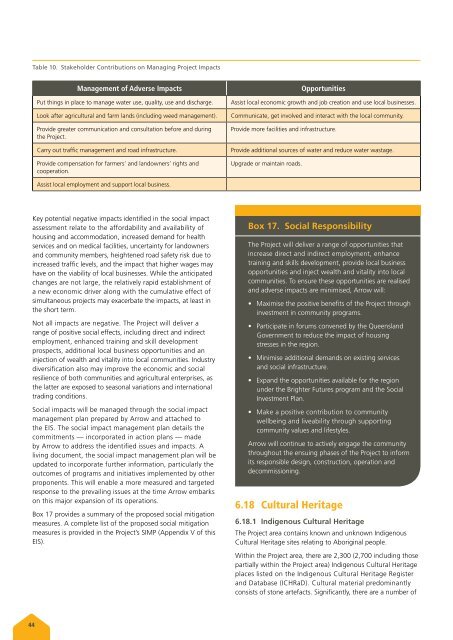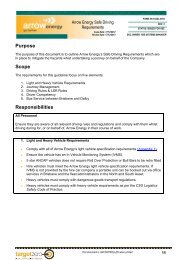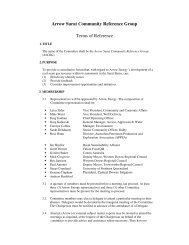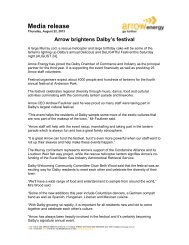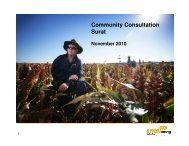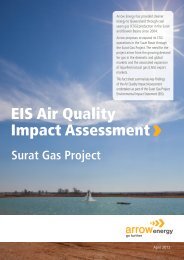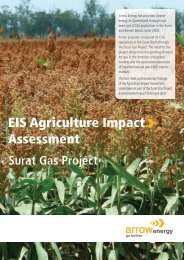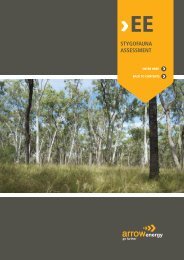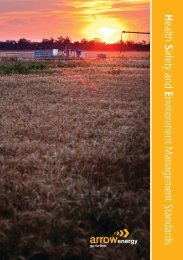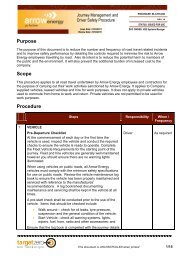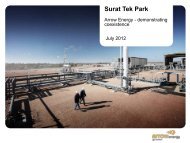Arrow Bowen GAs Project - Arrow Energy
Arrow Bowen GAs Project - Arrow Energy
Arrow Bowen GAs Project - Arrow Energy
You also want an ePaper? Increase the reach of your titles
YUMPU automatically turns print PDFs into web optimized ePapers that Google loves.
Table 10. Stakeholder Contributions on Managing <strong>Project</strong> Impacts<br />
Management of Adverse Impacts<br />
Put things in place to manage water use, quality, use and discharge.<br />
Look after agricultural and farm lands (including weed management).<br />
Provide greater communication and consultation before and during<br />
the <strong>Project</strong>.<br />
Carry out traffic management and road infrastructure.<br />
Provide compensation for farmers’ and landowners’ rights and<br />
cooperation.<br />
Opportunities<br />
Assist local economic growth and job creation and use local businesses.<br />
Communicate, get involved and interact with the local community.<br />
Provide more facilities and infrastructure.<br />
Provide additional sources of water and reduce water wastage.<br />
Upgrade or maintain roads.<br />
Assist local employment and support local business.<br />
Key potential negative impacts identified in the social impact<br />
assessment relate to the affordability and availability of<br />
housing and accommodation, increased demand for health<br />
services and on medical facilities, uncertainty for landowners<br />
and community members, heightened road safety risk due to<br />
increased traffic levels, and the impact that higher wages may<br />
have on the viability of local businesses. While the anticipated<br />
changes are not large, the relatively rapid establishment of<br />
a new economic driver along with the cumulative effect of<br />
simultaneous projects may exacerbate the impacts, at least in<br />
the short term.<br />
Not all impacts are negative. The <strong>Project</strong> will deliver a<br />
range of positive social effects, including direct and indirect<br />
employment, enhanced training and skill development<br />
prospects, additional local business opportunities and an<br />
injection of wealth and vitality into local communities. Industry<br />
diversification also may improve the economic and social<br />
resilience of both communities and agricultural enterprises, as<br />
the latter are exposed to seasonal variations and international<br />
trading conditions.<br />
Social impacts will be managed through the social impact<br />
management plan prepared by <strong>Arrow</strong> and attached to<br />
the EIS. The social impact management plan details the<br />
commitments — incorporated in action plans — made<br />
by <strong>Arrow</strong> to address the identified issues and impacts. A<br />
living document, the social impact management plan will be<br />
updated to incorporate further information, particularly the<br />
outcomes of programs and initiatives implemented by other<br />
proponents. This will enable a more measured and targeted<br />
response to the prevailing issues at the time <strong>Arrow</strong> embarks<br />
on this major expansion of its operations.<br />
Box 17 provides a summary of the proposed social mitigation<br />
measures. A complete list of the proposed social mitigation<br />
measures is provided in the <strong>Project</strong>’s SIMP (Appendix V of this<br />
EIS).<br />
Box 17. Social Responsibility<br />
The <strong>Project</strong> will deliver a range of opportunities that<br />
increase direct and indirect employment, enhance<br />
training and skills development, provide local business<br />
opportunities and inject wealth and vitality into local<br />
communities. To ensure these opportunities are realised<br />
and adverse impacts are minimised, <strong>Arrow</strong> will:<br />
• Maximise the positive benefits of the <strong>Project</strong> through<br />
investment in community programs.<br />
• Participate in forums convened by the Queensland<br />
Government to reduce the impact of housing<br />
stresses in the region.<br />
• Minimise additional demands on existing services<br />
and social infrastructure.<br />
• Expand the opportunities available for the region<br />
under the Brighter Futures program and the Social<br />
Investment Plan.<br />
• Make a positive contribution to community<br />
wellbeing and liveability through supporting<br />
community values and lifestyles.<br />
<strong>Arrow</strong> will continue to actively engage the community<br />
throughout the ensuing phases of the <strong>Project</strong> to inform<br />
its responsible design, construction, operation and<br />
decommissioning.<br />
6.18 Cultural Heritage<br />
6.18.1 Indigenous Cultural Heritage<br />
The <strong>Project</strong> area contains known and unknown Indigenous<br />
Cultural Heritage sites relating to Aboriginal people.<br />
Within the <strong>Project</strong> area, there are 2,300 (2,700 including those<br />
partially within the <strong>Project</strong> area) Indigenous Cultural Heritage<br />
places listed on the Indigenous Cultural Heritage Register<br />
and Database (ICHRaD). Cultural material predominantly<br />
consists of stone artefacts. Significantly, there are a number of<br />
44


